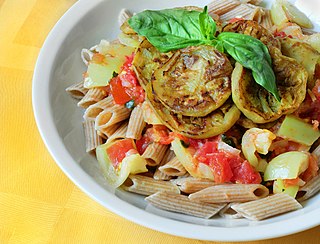
Aspartame is an artificial non-saccharide sweetener 200 times sweeter than sucrose and is commonly used as a sugar substitute in foods and beverages. It is a methyl ester of the aspartic acid/phenylalanine dipeptide with the trade names NutraSweet, Equal, and Canderel. First submitted for approval as a food ingredient in 1974, aspartame was approved by the US Food and Drug Administration (FDA) in 1981.

Stevia is a natural sweetener and sugar substitute derived from the leaves of the plant species Stevia rebaudiana, native to Paraguay and Brazil.
A sweetener is a substance added to food or drink to impart the flavor of sweetness, either because it contains a type of sugar, or because it contains a sweet-tasting sugar substitute. Various natural non-sugar sweeteners and artificial sweeteners are used to produced food and drink.

Sucralose is an artificial sweetener and sugar substitute. The majority of ingested sucralose is not broken down by the body, so it is noncaloric. In the European Union, it is also known under the E number E955. It is produced by chlorination of sucrose, selectively replacing three of the hydroxy groups in the C1, C4, and C6 positions to give a 1,6-dichloro-1,6-dideoxyfructose–4-chloro-4-deoxygalactose disaccharide. Sucralose is about 320 to 1,000 times sweeter than sucrose, three times as sweet as both aspartame and acesulfame potassium, and twice as sweet as sodium saccharin.

Splenda is a global brand of sugar substitutes and reduced-calorie food products. While the company is known for its original formulation containing sucralose, it also manufactures items using natural sweeteners such as stevia, monk fruit and allulose. It is owned by the American company Heartland Food Products Group. The high-intensity sweetener ingredient sucralose used in Splenda Original is manufactured by the British company Tate & Lyle.

A sugar substitute is a food additive that provides a sweetness like that of sugar while containing significantly less food energy than sugar-based sweeteners, making it a zero-calorie or low-calorie sweetener. Artificial sweeteners may be derived through manufacturing of plant extracts or processed by chemical synthesis. Sugar substitute products are commercially available in various forms, such as small pills, powders, and packets. Natural sweeteners include stevia, maple syrup, and agave nectar.

Cyclamate is an artificial sweetener. It is 30–50 times sweeter than sucrose, making it the least potent of the commercially used artificial sweeteners. It is often used with other artificial sweeteners, especially saccharin; the mixture of 10 parts cyclamate to 1 part saccharin is common and masks the off-tastes of both sweeteners. It is less expensive than most sweeteners, including sucralose, and is stable under heating. Safety concerns led to it being banned in a few countries, though the European Union considers it safe.

Saccharin, often used in the form of sodium saccharin, is an artificial sweetener with effectively no nutritional value. It is about 550 times as sweet as sucrose but has a bitter or metallic aftertaste, especially at high concentrations. Saccharin is used to sweeten products such as drinks, candies, cookies, and especially for masking the bitter taste of some medicines.

Acesulfame potassium, also known as acesulfame K or Ace K, is a synthetic calorie-free sugar substitute often marketed under the trade names Sunett and Sweet One. In the European Union, it is known under the E number E950. It was discovered accidentally in 1967 by German chemist Karl Clauss at Hoechst AG. In chemical structure, acesulfame potassium is the potassium salt of 6-methyl-1,2,3-oxathiazine-4(3H)-one 2,2-dioxide. It is a white crystalline powder with molecular formula C
4H
4KNO
4S and a molecular weight of 201.24 g/mol.

Diet or light beverages are generally sugar-free, artificially sweetened beverages with few or no calories. They are marketed for diabetics and other people who want to reduce their sugar intake.

Erythritol is an organic compound that is a naturally occurring, four-carbon sugar alcohol (or polyol). It is used as a food additive and sugar substitute. It is synthesized from corn using enzymes and fermentation. Its formula is C
4H
10O
4, or HO(CH2)(CHOH)2(CH2)OH.

High-fructose corn syrup (HFCS), also known as glucose–fructose, isoglucose and glucose–fructose syrup, is a sweetener made from corn starch. As in the production of conventional corn syrup, the starch is broken down into glucose by enzymes. To make HFCS, the corn syrup is further processed by D-xylose isomerase to convert some of its glucose into fructose. HFCS was first marketed in the early 1970s by the Clinton Corn Processing Company, together with the Japanese Agency of Industrial Science and Technology, where the enzyme was discovered in 1965.

D-Psicose (C6H12O6), also known as D-allulose, or simply allulose, is a low-calorie epimer of the monosaccharide sugar fructose, used by some major commercial food and beverage manufacturers as a low-calorie sweetener. First identified in wheat in the 1940s, allulose is naturally present in small quantities in certain foods.

Diet food refers to any food or beverage whose recipe is altered to reduce fat, carbohydrates, and/or sugar in order to make it part of a weight loss program or diet. Such foods are usually intended to assist in weight loss or a change in body type, although bodybuilding supplements are designed to increase weight.

Agave syrup, also known as maguey syrup or agave nectar, is a sweetener commercially produced from several species of agave, including Agave tequilana and Agave salmiana. Blue-agave syrup contains 56% fructose as a sugar providing sweetening properties.
Merisant is an American manufacturer of zero/low-calorie sugar substitutes. It is a wholly owned subsidiary of MacAndrews & Forbes and is headquartered in Chicago, Illinois. Merisant markets brands in over 90 countries including Equal and Canderel, as well as natural sweeteners PureVia and Whole Earth featuring stevia and monkfruit extract. In 2021, Merisant was ranked 12th on the Top 50 Global Sweetener Companies list by FoodTalks.
Hydrogenated starch hydrolysates (HSHs), also known as polyglycitol syrup, are mixtures of several sugar alcohols. Hydrogenated starch hydrolysates were developed by the Swedish company Lyckeby Starch in the 1960s. The HSH family of polyols is an approved food ingredient in Canada, Japan, and Australia. HSH sweeteners provide 40 to 90% sweetness relative to table sugar.
Truvia is a brand of stevia-based sugar substitute developed jointly by The Coca-Cola Company and Cargill. It is distributed and marketed by Cargill as a tabletop sweetener as well as a food ingredient. Truvia is made of stevia leaf extract, erythritol, and natural flavors. Because it comes from the stevia plant, Cargill classifies Truvia as a natural sweetener in addition to being a non-nutritive sweetener, although Cargill has settled lawsuits alleging deceptive marketing of Truvia as "natural". Since its launch in 2008, Truvia natural sweetener has become the second best-selling sugar substitute in units in the U.S. behind Splenda, surpassing Equal and Sweet'n Low. Truvia competes with Stevia In The Raw, the #2 brand of stevia, owned by Cumberland Packaging who also makes Sweet 'n Low.

A sugar packet is a delivery method for one serving of sugar or other sweetener. Sugar packets are commonly supplied in restaurants, coffeehouses, and tea houses, where they are preferred to sugar bowls or sugar dispensers for reasons of neatness, sanitation, spill control, and to some extent portion control.















